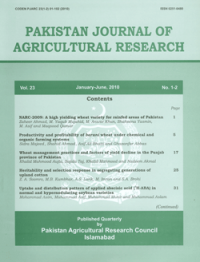IMPACT OF VARIABLE SEEDING DATES ON CEREALS' PERFORMANCE UNDER AGRO-ECOLOGICAL CONDITIONS OF DERA ISMAIL KHAN
Shahid Iqbal Khattak*, Muhammad Amjad Nadim**, Mohammad Safdar Baloch**, Kashif Waseem** and Muhammad Sohail***
ABSTRACT
Performance of cereals was studied through a two factors field experiment under split-plot arrangements at Agricultural Research Institute, D.I.Khan during 2012-13. Four cereals (wheat, triticale, barley, oat) were assigned to main plots while six different sowing dates (October 15, November 1 & 15, December 1 & 15 and January 1) were kept in subplot. The experiment was replicated four times with a sub-plot size of 5 m × 1.8 m (9 m ). Sowing of barley took minimum time to 50 % heading (99.08 days) which led the same towards earlier maturity (131.21 days) while oat crop showed prolonged maturity (147.67 days). Regarding yield, the four cereals showed non-significant results. Among different dates, January 1 sowing had the poorest performance in almost all parameters. However, the highest grain yield (3104 kg ha ) was produced by October 15 sowing while the results of November 15 and thereafter sowing were nonsignificant with each other. Data on lodging of these cereal crops was also observed during the study. Barley was the crop showing maximum lodging (35.83 %) which led the same to lowest grain yield. The minimum lodging (8.33 %) was noted in oat crop. It was also observed that earlier sowing showed more lodging due to longer growth period. The study concludes that cereals should be sown between mid-October to mid-November for their best performance in areas with similar agro-ecology.
To share on other social networks, click on any share button. What are these?






